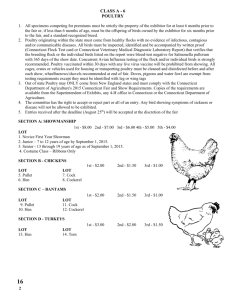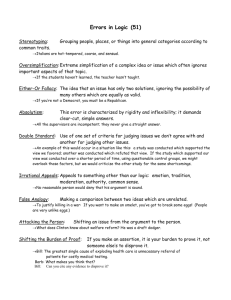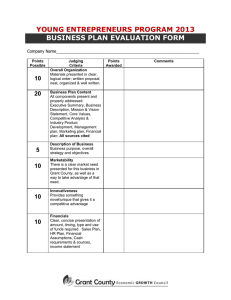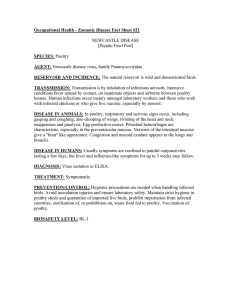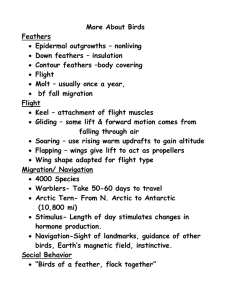u Po it d Eggs Judging
advertisement
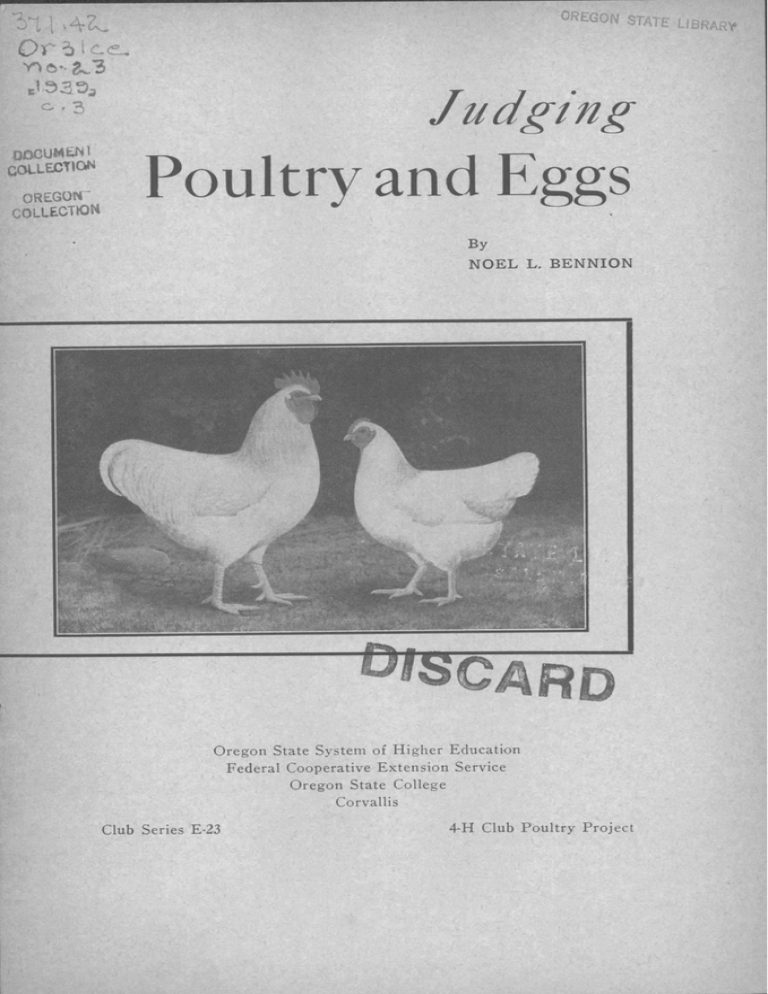
OREGON STATE Orc. Judging OoCUM.1l OREGON Po uit ry a nd Eggs COLLECTI By NOEL L. BENNION Oregon State System of Higher Education Federal Cooperative Extension Service Oregon State College Corvallis Club Series E-23 4-H Club Poultry Project L8RA? S TABLE OF CONTENTS Page INTRODUCTION---------------------------------------------------------------------------------------------- 3 JUDGING FOR EGG PRODUCTION 3 Present Production ---------------------------------------------------------------------------------------- 3 PastProduction ---------------------------------------------------------------------------------------------- 4 Rateof Production ------------------------------------------------------------------------------------------ 7 JUDGING FOR EXHIBITION ---------------------------------------------------------------------- 8 General Disqualifications ---------------------------------------------------------------------------- 9 GeneralDefects ---------------------------------------------------------------------------------------------- 10 BreedDescriptions ---------------------------------------------------------------------------------------- 10 WhiteLeghorns -------------------------------------------------------------------------------------------- 11 RhodeIsland Red ------------------------------------------------------------------------------------------ 11 PlymouthRocks -------------------------------------------------------------------------------------------- 12 JUDGING FOR MEAT PRODUCTION ---------------------------------------------------- 13 Standards for Judging Live-market Poultry ------------------------------------------ 14 Scale of Points for Judging Live-market Poultry ------------------------ 15 Standards for judging Dressed-market Poultry ------------------------------------ 15 Scale of Points for Judging Dressed Poultry -------------------------------- 17 JUDGINGEGGS -------------------------------------------------------------------------------------------------- 17 Scale of Points for Judging Eggs ---------------------------------------------------- 19 ORALREASONS ------------------------------------------------------------------------------------------------ 19 Judging Poultry and Eggs By NoEL L. BvN N TON, Extension Poultryrnan INTRODUCTION TI IF 4-H Club poultry-judgiiig contest is designed to give club members training in judging eggs and in judging poultry for exhibition and for meat and egg production. The poultryiudging contest as set up in Oregon at present consists of eight classes: three classes of birds for production, three classes for exhibition, one class of live birds for meat production, one class of white eggs. In the national 4-H Club contest, oral reasons are given on one class of exhibition and one class of production birds. This may be included in Oregon's state contest and club members should he prepared to give reasons on any two of the various classes. The three most common breeds and varieties used in poultryjudging contests are S. C. White Leghorns, S. C. Rhode Island Reds, and Barred or White Plymouth Rocks. The classes may be made up of pullets, or hens ; sometimes a class of male birds is used in exhibition judging. Four birds constitute a class and they are judged and placed by comparison. fri judging eggs, four single dozen make up a class and these are also judged and placed by comparison. Eggs may be judged by exterior quality only, or if egg candling equipment is available, they may be judged according to exterior and interior quality. One of the first essentials in poultry judging is to learn the nomenclature of the fowl in order to speak and understand the terms used in poultry judging. JUDGING FOR EGG PRODUCTION Birds to be judged for egg production are placed according to their egg-laying characteristics, which are indicated by present production, past production, and rate of production. Present production Present production is indicated by the condition of the cornl), wattles, pubic bones, and vent. If a hen is laying, her comb and wattles will be large, bright red, and soft ; the pubic hones will be spread and flexible ; and the vent will he moist and dilated. When 4 CLUB SERIES E-23 a hen is out of production, the comb and wattles will he small, pale, and scaly; the 1rnbic bones will be rigid and close together, and the vent will be dry and contracted. Past production I ast production is determined mainly by pigmentation and molt. Pigmentation is the yellow color that appears in the body of POLYZ) Figure I. Nomenclature of the Fowl (Courtesy U. S. Deportment of Agriculture) JUDGING POULTRY AND EGGS yellow-skinned breeds, mainly in the beak and shanks. As a hen continues to lay, the pigment leaves the body in the following order: vent from 5 to 10 days, eyerings about two weeks, ear lobes three weeks, beak 4 to 6 weeks, and shanks 4 to 6 months. As the pigment leaves the beak it starts to fade at the base and gradually works out. In leaving the shanks, the bottom of the feet are bleached first, the front of the shanks next, and the back of the shanks last. \\Then a hen goes out of production, the pigment returns in the same order in which it leaves. It first returns to the vent, then the everings, ear lobes, beak, and shanks. While it takes four to six months for the pigment to leave the body it will return in four to six weeks. There is quite a variation among individual hens as to the rate at which the pigment leaves and returns to the body. This is influenced to a certain extent by feed, texture of skin, and rate of production. A fast-laying hen or a hen with high intensity will have a tendency to lose her pigment sooner than the slow producer. In judging for egg production, as a rule the vigorous bird that possesses the least yellow pigment has been the best producer. After a hen has been in production for about six months and the pigment has all disappeared the molt is the best indication as to her production. The time of year and rate at which the bird molts is a good indication of past production and also length of time she will continue to lay. The high-producing hens will continue to lay through the summer and will not molt until September or October. The lowerproducing hens will molt in June, July, or August. As a rule, the poorest producers will be the first to start molting. The order of molt is head, neck, body, wing, and tail. The outer ten feathers of the wing are called the primary feathers and the order of the molt is quite regular. The molt in the primary feathers is used as a guide to determine the length and rate of molt, which are indicaof production. tions Usually the wing is made up of ten primary feathers and fourteen secondary feathers, which are divided by a short axil feather. The first primary feather to drop out is the one next to the axil and the molt continues outward in the ten primaries. The low producers will drop one feather at a time and the high producers may drop from 3 to 5 at once. The feathers are dropped about two weeks apart. It takes about six weeks for the new feathers to com- plete their growth. If a hen just drops one primary at a time, it 6 CLI.Tt S1RI1:s E-23 will take her about 24 weeks to complete the molt. If a high- producing hen drops five primaries at once, she will ccmplete the molt in about eight weeks. Generally speaking, after a hen starts the wing molt, she will stop hiving, and will not start again until the molt is finished. Occasionallv a high-producing hen with considerable vitality will continue to lay while molting. The club member should keel) in mind that the low producers molt early and slowly and the high producers molt late and fast. B C D Figure 2 Showing wing molt. /1, a normal vitig showing the primary feathers, I to 10. They are separated from the secondary feat tier (in dotted outline) by a short axil feather, X. B, the beginning of a wing molt. I and 2 are ii ew feath era growing in C, an 8-week molt. 3 md 4 are lint counted until fully grown. D, an instance (alniornial) in which five feat hers only were niotted. Ii, a wing cointilet lug a normal molt. (C all it iSV Knaves .4uric itt v-al B.rperivvv eat Station.) JUDGING POULTRY AND EGGS Rate of production Some hens have a much fastet rate of production than others. For example, some hens may lay only every other day, others may mv two days and miss a day, while others will lay many eggs be fore a day is missed. The best indication for rate of production is the handling quality of the bird, which is indicated by texture of skin and condition of abdomen, pubic bones, and keel bone. A hen with a high rate of production will often show more refinement about the head, the skin will be loose, soft, and pliable, the keel will slope downward, the abdomen will he soft, pliable, and free from fat, the pubic bones will be thin, flexible, and well spread. A hen with low rate of production will usually show more coarseness about the head, the skin will be thick and underlaid with fat, the abdomen will lack that soft, pliable texture and may carry considerable fat, the pubic bones will be thicker, rigid, and have a tendency to turn in. A CULLING CHART (From Kansas Agricultural Experiment Station Circular 147) un(; [NO FOR PRESENT PRODUcTION Laying lien Vent ---------------------- Large, dilated, oblong, moist Pubic bones -------- Flexible, wide apart Comb -------------------- Large, Wattles and red, full, glossy ear lobes ---------- Prominent, soft, smooth Nonlaying hen Small, contracted, round, dry Rigid, close together Small, pale, scaly Inconspicuous, rough, and dry [05 .1 NO FOR lOSS 1' plSOl)UcUION Long laying period Vent ---------------------- Bluish-white Eyelids ----------------- Thin, Short laying period Flesh-colored and edges white, promi- nent, keen, sparkling Ear lobes ------------- Enamel white Beak ---------------------- Pearly white Face ----------------------- Clean-cut, sunken Shanks ------------------ White, flat, thin, creased Plumage --------------- \Vorn, soiled, lifeless, closefeathered Listless, sunken Yellow-tinted Yellow-tinted Full, well-fleshed, yellowish Yellow, round, smooth Signs of molting, loosefeathered CLUB SERIES E-23 8 JUDGING FOR RATE OF PRODUCTION High rate Keel ---------------------- Slopes downward Pubic bones ------ Tips thin, points straight Capacity --------------- Four to five fingers Abdomen ------------- Soft, pliable, dilated Rump -------------------- Broad, width carried back Skin ----------------------- Soft, thin, loose, silky Lateral pro- Low rate Slopes upward Tips thick, curved in Two fingers Fatty, hard, contracted Narrow, cramped Thick, dry, underlaid with fat cesses ----------------Prominent, pointed outward Hard to find, pointed inward Figure 3. Showing heads of a high-producing hen and a cull. (Courtesy U. S. Department of Agriculture) JUDGING FOR EXHIBITION Birds judged for exhibition are placed according to both body conformation and plumage color, as described in the American Standard of Perfection. The "Standard" is a book published by the American Poultry Association and gives a detailed description of the various breeds and varieties of poultry and their defects and disqualifications. For more detailed work in exhibition judging it should be used as a guide. JUDGING- POULTRY AND EGGS 9 In exhibition judging it is important that club members have in mind a definite picture of the plumage requirements, proper body type or conformation, and standard weights of the breeds to be judged. In selecting birds for judging, an attempt is made to select birds that are free from disqualifications; however, club members should know the important disqualifications and defects for the more common breeds. A disqualification is a fault serious enough to eliminate the bird from competition. A defect is a fault not serious enough to eliminate the bird from competition but which should be taken into consideration in judging and placing the birds. General disqualifications 1. "Deformed beaks, crooked or otherwise deformed backs." 2. "A wing showing clipped primaries or secondaries, or both." 3. "A split wing" (abnormal division between primary and secondary wing feathers). 4. "A slipped wing" (carried in a drooping position). 5. Twisted feather or feathers in the wing or tail of any specimen. 6. "Side sprig or sprigs on all single-comb varieties." 7. "Positive enamel white in the ear lobes of males or females of all American, Asiatic, and English varieties except Chanticleers, Dorkings, and Redcaps." 8. "Stub, stubs, feather, feathers, or featherlike growth on the shanks, feet, or toes of breeds required to have unfeathered shanks." 9. "Any down, stub, feathers, or feather like growth on the hock discontinued from feather on thigh." 10. "Shank, shanks, foot, feet, or toes of color foreign to breed." 11. Black in the quills or primaries or secondaries of white varieties. 12. "Foreign color in any part of the plumage of white varieties, except slight gray ticking." 13. "One or more entirely white feathers showing in outer plumage of Rhode Island Reds." 14. "Red or yellow in any part of plumage; two or more solid-black primaries, or two or more solid-b'ack secondaries, or two or more solid-black main tail feathers in Barred Plymouth Rocks. CLUB SERIES E-23 10 15. Rhode Island Reds or Plymouth Rocks falling two pounds below standard weight; Leghorn males below one and one-half pounds; and Leghorn females below one pound. General defects 1. "Crooked breast or keel bone." 2. "Slate under color in Rhode Island Reds." 3. "Light-colored shafting in buff and red varieties." 4. "Mealiness in plumage or smutty under color in Reds." 5. "Black feathers in Barred Plymouth Rocks." 6. "Irregular barring in Barred Plymouth Rocks." 7. "Gray specks in any part of plumage of white varieties." 8. "Brassiness or yellow in all varieties." 9. "Creaminess of plumage or quill in white varieties, except where specified creamy white." 10. Lack of tail development. Breed descriptions Inasmuch as S. C. White Leghorns, S. C. Rhode Island Reds, and Barred or White Plymouth Rocks are the breeds generally used in poultry-judging contests, pictures and a brief description of the ideal bird and some of the common faults will be given for these breeds and varieties. Figure 4. Single-comb White Leghorns. (Courtesy Poultry Tribune.) JUDGING POULTRY AND EGGS 11 White Leghorns Exhibition Leghorns are known as the breed with the graceful curves. The head should be carried high and have an alert appearance. The back should be long, nearly horizontal, and blend with the tail in a long, graceful sweep. The tail of the male should be carried at a 40-degree angle and the tail of the female at a 35degree angle above the horizontal. The breast should be full, well rounded, and carried forward. Leghorns should be close feathered with the wings pressed tightly to the sides. Some of the more common faults are: high tails, wry tails, flat or shallow breasts, too sharp a break at the base of the tail, light-colored eyes, unbalanced bodies, brassiness or creaminess in plumage, and large, coarse, irregular combs. Standard weights for Leghorns: Cock ------------------ 6 pounds Cockerel ------------ 5 pounds Hen ------------------ 4 pounds Pullet ---------------- 4 pounds Rhode Island Reds Rhode Island Reds are often spoken of as the breed with a rectangular, or brick, shape. The back should be long and carried Figure 5. Single comb Rhode Island Reds. (Courtesy Poultry TribUne.) 12 CLUB SERIES E-23 in a horizontal position just about parallel to the ground and should rise slightly at the tail. The tail should be carried at a 40degree angle in the males and at a 30-degree angle In the females. One of the outstanding characteristics of the Rhode Island Reds is the long, straight back. The general plumage color should be an even dark red with some black in the wing and tail feathers. The under plumage should be of the same color. Some of the more common faults are: lack of typical Red shape; uneven or too light surface color; smutty or whitish under color; black feathers in body plumage; long legs, narrow backs; and lack of breast development. Standard weights for Rhode Island Reds: Cock ---------------- 8 pounds Cockerel ---------- 7 pounds Hen ------------------ 6 pounds Pullet -------------- 5 pounds Plymouth Rocks The two most common varieties of Plymouth Rocks used in judging contests are the Barred and White. The only difference between these varieties is the color of the plumage. The White Plymouth Rocks should have pure-white plumage. Barred Plvinouth Rocks should have a grayish-white color, which is produced Figure 6. Barred Plymouth Rocks. (Courtesy Poultry Tribune.) J LWGING POULTRY AND Ecc,s 13 by regular, narrow, parallel, black and white bars across each feather. The bars should be of equal width and extend the length of the feather, each feather ending with a narrow black tip. In the past, the American Standard of Perfection has recognized two varieties of Barred Plymouth Rocks, the Light- and Dark-Barred; but in the revised edition just the one variety is listed, Barred Plymouth Rocks. In regular Barred Rocks, the female is darker than the male because of wider black bars. The Plymouth Rocks should be rather upstanding with long, wide, deep bodies. The breast should be prominent and the under line somewhat curved rather than parallel with the back, as in the Rhode Island Reds. The general appearance of the body should he one of curves. The back should be nearly flat in the middle but rise gradually to the tail. The tail should be carried at a 30-degree angle above the horizontal in the male and at a 20-degree angle in the female. Some of the most common faults in Plymouth Rocks arc: flat breasts; overly long legs; knock knees; irregular combs; brassiness, creaminess and gray ticking in the plumage of the White variety; irregular barring, solid-black feathers, and a brassy or yellow sheen in plumage of the Barred variety. Standard weiqlzt for Plvnzouth Rocks: Cock ................ 9 pounds Cockerel ............ 8 pounds Hen .................. 7 pounds Pullet ................ 6 pounds JUDGING FOR MEAT PRODUCTION Poultry to be judged for meat production may be divided into two divisions, live and dressed. Under these divisions there may he classes for broilers, fryers, roasters, fowls, cocks, and capons. Broilers are young chickens from 8 to 12 weeks of age, of either sex, not weighing over 2.1 pounds. Fryers are young chickens from 14 to 20 weeks of age, of either sex, weighing over 2 pounds and not over 3 pounds. Roasters are young chickens from 5 to 9 months of age, of either sex, weighing over 3 pounds. Fowls are mature female birds of any age. Cocks are mature male birds of any weight with darkened and toughened flesh. Capons are unsexed male birds weighing over 4 pounds, usually from 7 to 10 months of age. CLUB SI:RIEs 14 E-23 Standards for judging live-market poultry A market bird must be in good physical condition and be free from diseases. The ideal bird should have a deep compact body, with a broad thick breast, straight broad back, fairly long straight keel, short legs, large thighs, and a soft pliable skin. A market bird must be in good flesh and the fat should be evenly distributed over the entire body. The flesh should be firm, vet pliable and soft. Some of the more common faults with live market birds are: lack of condition, under-sized, uneven distribution of fat, drop crop, large heavy abdomen, crooked breast bone, deformed back, coarse heavy skin and hones. The following standards for grading live-market poultry have been adopted from U. S. grades. GRADE A. The birds must he vigorous, well fleshed, plump, and well feathered, with bright-red combs and soft, glossy skin. Birds of that class must be soft meated and free from tears and bruises. Excess abdominal fat and broken hones are not permitted. No crooked breasts or other deformities are allowed. They must be free from external evidence of disease. GRADE B. Birds must be fairly well fleshed, fairly well feathered, free from tears or bruises broken hones are not permitted. Dented or slightly crooked breast bones or other slight deformities are permit- ted. Birds must be free from external evidence of disease. GRADE C. May be poorly feathered birds, poorly fleshed, hut not emaciated. Carcass may show a few scratches, tears, or bruises. Deformed birds are permitted if fairly well fleshed. Not more than one broken bone is permitted. Birds must be free from highly infectious diseases. REJ i:crs Rejects include all birds that show evidence of sick condition, severe injury, extreme emaciation, or other conditions that render them unfit for food. Birds afflicted with the following cbseases are classed as rejects: roup, infectious bronchitis, fowl cholera, fowl typhoid, limberneck, and tuberculosis. Crop bound, crippled, and weak birds are also classed as rejects. 15 JUDGTNG POULTRY AND EGGS SCALE OF POINTS FOR JUDGING LIVE-MARKET POULTRY Points Breast and keel development ---------------------------------------------------------------------------30 Breast should he wide and heavily fleshed. Keel should he straight, long, and parallel with back. Conditionand vigor .......................................................................................... 15 Well fleshed, good physical condition, free from diseases. Back and spring of ribs .................................................................................... 15 Back should be broad, relatively flat, and width carried well back. Symmetry............................................................................................................ 15 Legsand thighs .................................................................................................. 10 Entire body should be balanced and symmetrical. Thighs should be thick and well fleshed. Shanks should be straight with moderate length. Headand neck Head should be short and broad, with strong, curved beak. Eyes should be bright, denoting health and vigor. Neck should be of 5 ----------------------------------------------------------------------------------------------------- medium length. Wingsand shoulders ----------------------------------------------------------------------------------------- Wings should be carried firmly. Shoulders should be wide, square, and flat. Breedcharacters ................................................................................................ 5 Purebreds should conform with existing standards of breed. Standards for judging dressed-market poultry I)ressed poultry are birds that have been killed by bleeding and sticking and the feathers removed. The desirable hotly conformation in dressed poultry should he the same as described for live-market birds. In addition to this, they must be properly bled and dressed. The head, mouth, throat, and feet should be washed clean and the carcass unsoiled. Birds should be free from feed in crop, pinfeathers, bruises, and torn skin. The entire body should he well covered with flesh and especially over the breast bone. Ihe breast bone should be straight and fairly long. The quality of skin mae be used as a guide as to the quality of meat. A soft fine skin indicates meat of good (luality. Some of the main objections in dressed poultry arc: crooked breast bone, uneven distribution of fat, feed in crop, soiled birds, Jack of condition, and birds that have been improperly bled. Freshly killed birds that have not been properly bled will soon show a reddish appearance of the skin. CLUB SERiES 16 E-23 The following are U. S. standards for grading dressed poultry: U. S. GRADE AA. Young, fine-grained, soft-meated birds with broad, full-fleshed breast, the entire carcass fully covered with fat, and with skin soft and glossy, lying close to the flesh. Must be well bled, well dressed, free from pin feathers, and have empty crops. No flesh or skin bruises allowed and only slight skin abrasions or dis- colorations permitted, none of which shall be on the breast. No crooked breasts or other deformities allowed. A broken wing above the wing tip or a broken leg not permitted. Must he dry picked or semiscald and dry packed. U. S. GRADE A. Young, soft-meated birds with well-fleshed breast. The entire carcass well covered with fat and with soft, glossy skin. Must he well bled, well dressed, practically free of pinfeathers, and have empty crops. No flesh bruises and only very slight skin bruises, abrasions, or (liscolorations permitted, none of which shall be on the breast. No crooked breasts or other deformities allowed. Broken wings above the wing tips or broken legs not permitted. Birds with crops properly removed and sewed up may he in- cluded in this grade. Must be dry picked or semiscalded and dry packed. U. S. GRADE B. Young, soft-meated birds with fairly well- fleshed breast and with carcass fairly well covered with fat. Must be fairly well bled and dressed and may show few scattered pinfeathers over the entire carcass. Crop must he practically empty. Slight flesh or skin bruises, abrasions, or discolorations permitted, but not more than three such defects to each bird. Abrasions or tears over three inches in diameter not allowed except on the back or wing unless properly sewed up. Dented or slightly crooked breastbones or other slight deformities permitted. One broken wing or one broken leg in the flesh permitted if bone does not protrude through the flesh and is not showing excessive bruise or blood clots. U. S. GRADE C. Young birds with poorly fleshed breast and with carcass poorly covered with fat. May show evidence of poor bleeding and have numerous pinfeathers over the entire carcass. Abrasions and discolorations permitted and hunchback or other deformities allowed, if birds are fairly well fleshed. Birds badly bruised so as to make any appreciable part of the carcass inedible or birds emaciated or showing external evidence of disease not permitted. No GRADE. Birds that are extremely emaciated or showing evidence of disease, such as to render them unwholesome, are barred from all U. S. grades. 17 JUDGING POULTRY AND EGGS GRADES FOR OLD MALES AND OLD FEMALES. Old males and f emales are classified the same as young birds of same sex and the same specifications are used, except that due allowance is made for more firmness of flesh and other characteristics peculiar to maturity. SCALE OF POINTS FOR JUDGING DRESSED POULTRY Points Breast and keel development ------------------------------------------------------------------------ 30 Conditionand quality -------------------------------------------------------------------------------------- 20 Breast should be broad and heavily fleshed. Keel should be straight, long, and well covered with flesh. The flesh should be firm, yet pliable and soft and free from patchiness. Properly killed and dressed ---------------------------------------------------------------------------- 20 Backand spring of ribs ---------------------------------------------------------------------------------- 10 Must be well bled, well dressed, free from pinfeathers, and have empty crop. Back should be broad, relatively flat, with width carried well back. Back should be well covered with flesh. Legsor thighs ---------------------------------------------------------------------------------------------------- Thighs should be thick and plump. Conditionof skin ---------------------------------------------------------------------------------------------The skin should be soft, fine textured, well picked, free from 10 10 tears, bruises, and blotches. 100 JUDGING EGGS White or brown eggs may be used in a judging contest and sometimes a class of each included. They may be judged by exterior quality only, or if egg candling equipment is available, they may be judged according to exterior and interior quality. Points to consider relative to exterior quality are: condition of shell, shell texture, color, size, shape, and uniformity. The shell should be smooth, clean, unwashed, sound, and of good texture. The eggs should be very uniform in color, size, and shape. White eggs should be chalk white in color and brown ones a uniform dark brown. A first-grade egg must weigh at least two ounces, or 24 ounces per dozen. The most desirable size for eggs is from 24 to 26 ounces per dozen. Some of the most common defects in exterior quality are: lack of uniformity, dirty eggs, extremely small or large eggs, oddshaped eggs, cracked and rough shells. Factors to consider on interior quality are: size of air cells, movable air cell, shell texture, meat spots, blood spots, amount of thick and thin albumen, and condition of yolk. The air cell in a first-grade egg should be not over inch and localized in the CLUB SERIES 18 E-23 large end of the egg, the shell should be sound, smooth, and of good texture, the albumen should appear firm and the yolk dimly visible. Eggs must be free from meat or blood spots and germ development. Eggs that are stale or of poor quality will have a large air cell, the albumen will be thin, and the yolk will he much more visible and mobile. If an egg contains a meat or blood spot, it will show up as a dark or foreign substance in the albumen. ;\ movable air cell is one that always remains at the highest point of the egg. It may he found in fresh, stale, or weak eggs. When a stale egg or an egg of poor quality is broken out, the albumen will he thin, watery, and will spread or flatten out. The yolk will be flat and very easily broken. Eggs of good quality will have a firm, thick albumen that is compact and upstanding. The yolk will stand up and be round in pp ra nec. U. S. Standards for gra(ling eggs are the following: U S. GRAD!: AA. The shell must be clean, sound, and normal. The air cell must not exceed inch in depth and must he regular. The yolk must he well centered, its outline indistinct, and it must be free from visible germ development and other defects or blemishes. The white must he firm and clear. 15. S. GRADE A. The shell must he clean, sound, and normal. The air cell must not exceed j inch in depth and must be regular except in the retail grade of U. S., A, when the air cell may be slightly tremulous. The yolk must he fairly well centered and its outline may be moderately defined. It may he slightly mobile but must be free from visible germ development and particularly free from other (Icfects or blemishes. The whites must he firm and clear. 15. S. GRAI)E B. The shell must he clean and sound but may he slightly abnormal. The air cell must not exceed inch in depth and may show movement not in excess of inch. The yolk outline may be well defined. The yolk may be mobile and may show slightly visible germ development and other definite but not serious (lefects. The white must he reasonably firm and clear. U. S. GRAD1: C. The shell must he clean and sound hut may he abnormal. The air cell may he over inch in depth, may show movement in excess of inch, and may be bubbly or free. The yolk may he plainly visible. It may he freely mobile and cast a (lark shadow. It may show clearly visible germ development but no blood, It may show other serious defects. The whites may be weak and watery. 19 JUDGING POULTRY AND EGGS SCALE OF POINTS FOR JUDGING EGGS Points Shelltexture -------------------------------------------------------------------------------------------------------- 20 Shell should be smooth, strong, free from checks antI other defects. Size------------------------------------------------------------------------------------------------------------------------ 20 Eggs should weigh from 24 to 28 ounces per dozen. No egg should weigh less than 2 ounces. Uniformityof size ---------------------------------------------------------------------------------------------- 15 Eggs should be very uniform in size. Uniformityof color ------------------------------------------------------------------------------------------ 15 Uniformityof shape ------------------------------------------------------------------------------------------ 15 White eggs should he pure white, brown eggs should be uniformly dark or light brown. Eggs should be uniform in shape. Conditionof shell -------------------------------------------------------------------------------------------- 15 Shell should be spotlessly clean but not washed. 100 ORAL REASONS The club member should have dednite reasons for placing the birds the way he does and be able to state them. Oral reasons should begin by stating the class, breed, sex, and order of placing. This should be followed with reasons for placing the top bird over the second highest and so on until reasons have been given for each placing. Reasons on a production class should include a comparison on present production, pigmentation, molt, and handling quality. Body type or conformation and plumage color may also be used as reasons in production judging. The reasons given in exhibition judging should include a cornparison on body type and plumage color. The major defects or disqualifications should be mentioned for each bird. Production characteristics may also he used as reasons in exhibition judging. Cooperative Extension Work in Agriculture and Home Economics Wni. A. Schoenfeld, Director Oregon State College, United States Department of Agriculture, and State Department of Education, Cooperating Printed and distributed in furtherance of the Acts of Congress of May S and June 30, 1914
